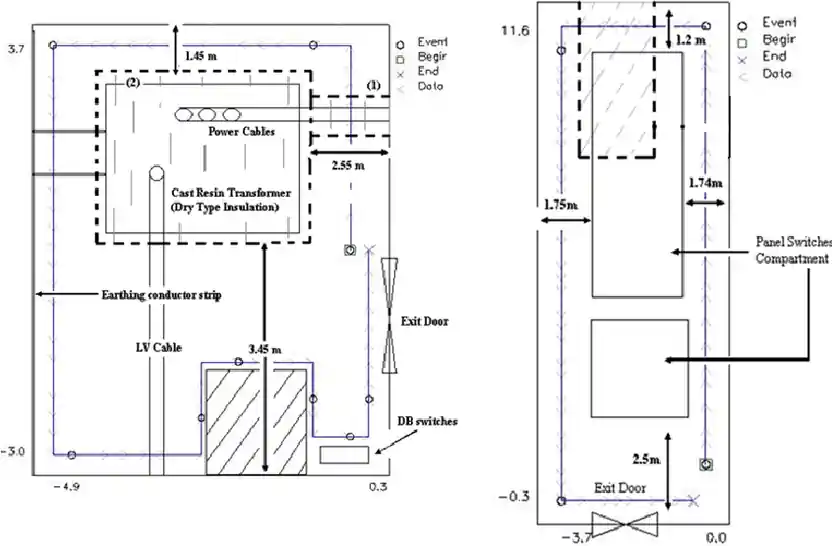Dans le domaine de l'infrastructure électrique, deux termes reviennent souvent lorsqu'il est question de la distribution de l'électricité.salle des interrupteurs et sous-station. Bien que ces termes soient parfois utilisés de manière interchangeable, ils jouent des rôles distincts au sein du réseau d'alimentation électrique. Comprendre les différences est essentiel pour les ingénieurs, les gestionnaires d'installations et les spécialistes de l'approvisionnement qui souhaitent concevoir des systèmes d'alimentation sûrs, évolutifs et efficaces.
Concept de base : Salle de commande vs. sous-station
A salle des interrupteurs est une zone désignée à l'intérieur d'un bâtiment ou d'une installation qui abrite l'appareillage de commutation basse et moyenne tensionIl s'agit d'un dispositif utilisé pour contrôler, protéger et isoler les circuits électriques. Il peut s'agir de disjoncteurs, d'isolateurs, de panneaux de contrôle et de barres omnibus, mais il ne s'agit pas d'un système de contrôle. ne comprennent généralement pas de transformateur d'alimentation.
A sous-stationEn revanche, il s'agit d'une installation plus complète qui comprend les éléments suivants Guide des transformateurs, appareillage de connexion, systèmes de protectionet équipement de contrôle pour abaisser ou élever les niveaux de tension entre les systèmes de transmission et de distribution.

Domaines d'application
Salle des interrupteurs
- Bâtiments commerciaux (hôtels, centres commerciaux)
- Installations industrielles (usines, usines de transformation)
- Centres de données et hôpitaux
- Installé à l'intérieur, généralement dans le plancher électrique ou le sous-sol.
Sous-station
- Réseaux électriques des services publics (transmission et distribution)
- Intégration des énergies renouvelables (fermes solaires/éoliennes)
- Aéroports, chemins de fer et grands projets d'infrastructure
- Peut être intérieur, extérieurou compact/préfabriqué

Tendances de l'industrie et évolution du marché
Avec l'essor des réseaux intelligents, des sous-stations modulaires et de l'intégration des énergies renouvelables, la conception et la fonctionnalité des sous-stations et des salles de commutation ont considérablement évolué.
Selon le Rapport 2023 de l'IEEMA sur les infrastructures électriquesLa préférence se porte de plus en plus sur les appareillage de commutation intelligent dans les salles de commutation équipées de Surveillance de l'IdO, détection de l'éclair d'arc électriqueet Intégration SCADA.
Dans le même temps, les entreprises de distribution d'électricité modernisent les postes électriques en les dotant d'une technologie de pointe. GIS (Gas-Insulated Switchgear) (appareillage de commutation isolé au gaz) et relais de protection numérique. Rapports de IEEE et Schneider Electric mettent également l'accent sur une convergence vers sous-stations hybrides qui combinent des équipements traditionnels avec des capteurs et des protocoles de communication avancés.
Comparaison technique
| Fonctionnalité | Salle des interrupteurs | Sous-station |
|---|---|---|
| Plage de tension | Basse et moyenne tension (BT/MV) | Moyenne à haute tension (MT/HT) |
| Comprend un transformateur ? | Non | Oui |
| Fonction principale | Contrôle et protection | Transformation de la tension et commutation |
| Équipement typique | Disjoncteurs, barres omnibus, isolateurs, panneaux de contrôle | Transformateur, disjoncteurs, relais, SCADA |
| Localisation | Intérieur (à l'intérieur du bâtiment) | Extérieur/intérieur/préfabriqué |
| Complexité de la construction | Modéré | Plus élevé |
| Respect des normes | IEC 61439, IEC 60947 | IEC 62271, IEEE C37, IEC 60076 |
Comment choisir : Salle de commande ou sous-station ?
Le choix dépend de plusieurs facteurs clés :
- Exigences en matière de tension
- Si vous manipulez des charges de 400 V ou de 11 kV à l'intérieur d'un bâtiment, une salle de commutation peut suffire.
- Pour un abaissement à partir de 33kV ou plus, une sous-station est indispensable.
- Contraintes liées à l'espace et au site
- Les salles de commutation nécessitent moins d'espace et sont intégrées dans les structures.
- Les sous-stations ont besoin de cours clôturées ou d'enceintes dédiées.
- Capacité de puissance
- Les sous-stations peuvent gérer des charges supérieures à 1 MVA, tandis que les salles de commutation gèrent généralement des capacités inférieures.
- Coordination des réglementations et des services publics
- Les sous-stations doivent souvent être approuvées par les services publics et sont connectées aux réseaux d'alimentation.
- Budget et délai de déploiement
- Les salles de commutation sont moins chères et plus rapides à construire.
- Les sous-stations impliquent des travaux de génie civil, la conception de la protection et l'interface avec les services publics.
Des fournisseurs de premier plan comme PINEELE, ABB, Eatonet Siemens offrent les deux solutions avec des personnalisations alignées sur CEI, ISet IEEE normes.
Sources et références faisant autorité
- Wikipedia - Poste électrique
- IEEE Std C37.100.1™: Guide d'application pour l'appareillage de connexion
- IEC 62271: Appareillage à haute tension
- Document technique ABB: "Considérations relatives à la conception des salles de commutation intérieures"
- Livre blanc de Schneider Electric: "Sous-stations numériques dans les réseaux urbains"
Ces références permettent de valider les décisions de conception et de garantir la sécurité et la conformité des opérations à long terme.
FAQ
A : Non. Une salle de commutation n'a pas la capacité de transformer la tension. Les sous-stations sont essentielles lorsqu'un échelonnement de la tension est nécessaire (par exemple, de 33 kV à 11 kV ou de 11 kV à 415 V).
A : Oui. De nombreux grands projets comportent un guide des postes électriques pour la transformation et une salle de commutation pour la distribution et le contrôle internes.
A : Pas nécessairement. Les deux peuvent être aussi sûrs l'un que l'autre s'ils sont correctement conçus. Les salles de commutation sont généralement situées à l'intérieur et plus faciles d'accès, mais les postes électriques sont souvent dotés de systèmes de protection plus avancés.
Comprendre la différence entre une salle de commutation et une sous-station est essentielle pour concevoir des systèmes de distribution électrique efficaces. Alors qu'une salle de commutation permet un contrôle compact à l'intérieur des bâtiments, une sous-station est indispensable pour solutions de tension la transformation et la distribution à grande échelle.


